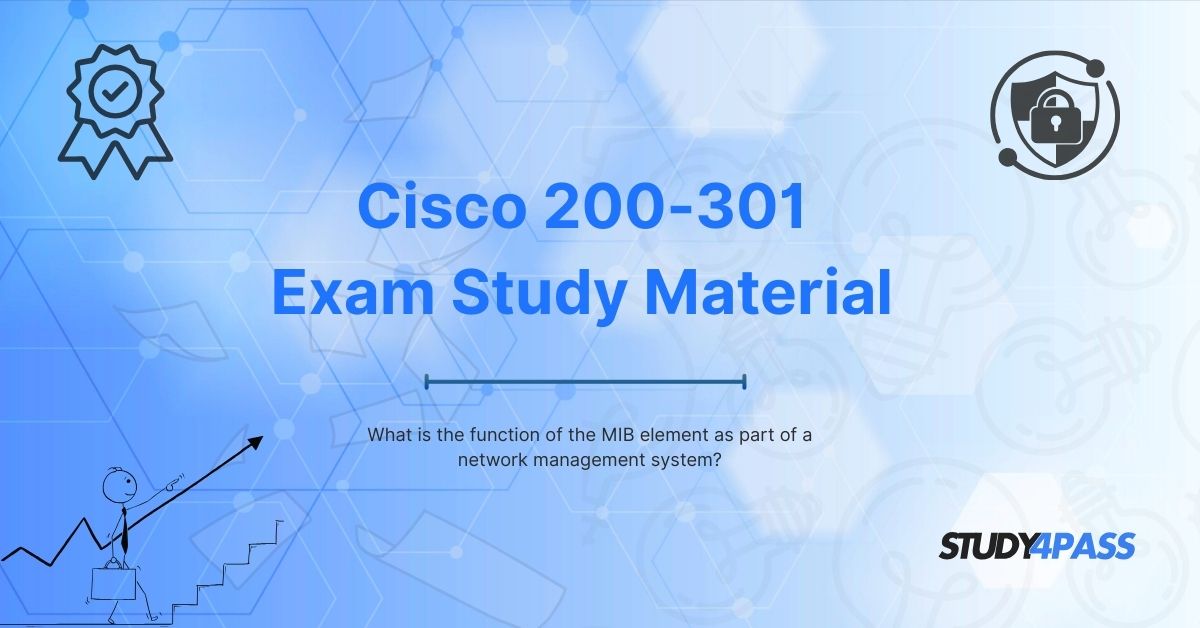Introduction
In the realm of network management, the Management Information Base (MIB) plays a crucial role in monitoring and controlling network devices. As part of the Simple Network Management Protocol (SNMP) framework, the MIB serves as a structured database that organizes and stores management information for network devices such as routers, switches, and servers.
For aspiring networking professionals pursuing certifications like CCNA, CCDA, CCENT, CCNA Security, and CCNA Wireless, understanding the MIB's function is essential. This article provides an in-depth exploration of the MIB element, its significance in network management, and its interaction with SNMP.
Additionally, for those preparing for Cisco certification exams, Study4Pass offers comprehensive study materials, practice tests, and expert guidance to help you succeed.
Understanding SNMP and MIB in Network Management
What is SNMP?
Simple Network Management Protocol (SNMP) is an application-layer protocol used for collecting and organizing information about managed devices on IP networks. It enables network administrators to monitor network performance, detect faults, and configure devices remotely.
SNMP operates using three primary components:
- Managed Devices (routers, switches, servers)
- SNMP Agent (software running on managed devices)
- Network Management System (NMS) (software like SolarWinds, PRTG)
What is MIB?
The Management Information Base (MIB) is a virtual database that stores hierarchical information about network devices in a standardized format. It defines the objects that can be managed via SNMP, allowing the NMS to query and modify device parameters.
Each object in the MIB is identified by an Object Identifier (OID), a unique numeric string that follows the ASN.1 (Abstract Syntax Notation One) structure.
Structure and Components of MIB
MIB Hierarchy and OIDs
The MIB is organized in a tree-like structure, where each node represents a managed object. The OID follows a dotted notation, such as:
1.3.6.1.2.1.1.1 (sysDescr)
- 1.3.6.1 – ISO, ORG, DOD, Internet
- 1.3.6.1.2.1 – MIB-2 (Standard MIB for TCP/IP devices)
- 1.3.6.1.2.1.1.1 – sysDescr (System description)
Types of MIBs
There are two main categories of MIBs:
- Standard MIBs – Defined by the Internet Engineering Task Force (IETF) and applicable to all SNMP-compatible devices (e.g., MIB-II).
- Vendor-Specific MIBs – Developed by manufacturers (Cisco, Juniper) to manage proprietary features.
MIB File Format
MIB files are written in SMI (Structure of Management Information) syntax and include:
- OBJECT-TYPE – Defines a manageable object.
- MODULE-IDENTITY – Specifies the MIB module.
- NOTIFICATION-TYPE – Defines SNMP traps.
Example of a MIB definition:
sysDescr OBJECT-TYPE
SYNTAX DisplayString (SIZE (0..255))
MAX-ACCESS read-only
STATUS current
DESCRIPTION "A textual description of the entity."
::= { system 1 }
Role of MIB in Network Management
Enabling SNMP Operations
The MIB facilitates SNMP operations by:
- GET – Retrieving device information (e.g., interface status).
- SET – Modifying device configurations (e.g., changing an IP address).
- TRAP/INFORM – Sending alerts for critical events (e.g., link failure).
Device Monitoring and Performance Tracking
Network administrators use MIB data to monitor:
- Bandwidth utilization (ifInOctets, ifOutOctets)
- CPU and memory usage (hrProcessorLoad, hrMemorySize)
- Error rates (ifInErrors, ifOutErrors)
Troubleshooting and Fault Detection
By analyzing MIB variables, administrators can identify:
- Network congestion (high packet drops)
- Device failures (unresponsive SNMP agents)
- Security breaches (unauthorized configuration changes)
MIB in Cisco Certifications (CCNA, CCNA Security, etc.)
For Cisco certification candidates, understanding MIB is crucial for:
- CCNA (200-301) – SNMP fundamentals, MIB structure.
- CCNA Security – Securing SNMP access (community strings, SNMPv3).
- CCNA Wireless – Monitoring wireless controllers via MIBs.
Practical Use Cases
- Configuring SNMP on a Cisco Router:
Router(config)# snmp-server community study4pass RO
Router(config)# snmp-server host 192.168.1.100 traps study4pass
- Querying MIB Values:
snmpwalk -v2c -c study4pass 192.168.1.1 1.3.6.1.2.1.1.1
Why Choose Study4Pass for Cisco Certification Preparation?
For candidates preparing for CCNA, CCDA, CCENT, CCNA Security, or CCNA Wireless, Study4Pass provides:
- Comprehensive Study Guides – Detailed explanations of SNMP, MIB, and network management.
- Practice Exams – Simulated tests with real exam scenarios.
- Hands-on Labs – Practical exercises for configuring SNMP and MIB queries.
- Expert Support – 24/7 assistance from certified professionals.
By leveraging Study4Pass, you can master MIB concepts and excel in your Cisco certification journey.
Conclusion
The MIB (Management Information Base) is a foundational element in network management, enabling efficient monitoring and control of network devices through SNMP. For Cisco Certification aspirants, mastering MIB operations is essential for configuring, troubleshooting, and optimizing network performance.
To enhance your preparation, Study4Pass offers top-tier study materials, practice tests, and expert guidance tailored for CCNA, CCNA Security, and other Cisco certifications. Start your journey today and achieve networking excellence!
Special Discount: Offer Valid For Limited Time “200-301 Exam Material”
Actual Exam Questions For Cisco's 200-301 Mock Exam
Sample Questions For Cisco 200-301 Exam Preparation
1. What is the primary function of the MIB (Management Information Base) in a network management system?
a) To monitor network traffic in real-time
b) To store and organize management information for network devices
c) To encrypt data transmitted across the network
d) To act as a firewall for network security
2. Which protocol commonly uses the MIB to retrieve and manage network device information?
a) HTTP
b) SNMP
c) FTP
d) TCP/IP
3. How does the MIB assist in network management?
a) By providing a graphical user interface for administrators
b) By defining a structured database of manageable objects in network devices
c) By automatically repairing faulty network connections
d) By blocking unauthorized access to the network
4. What type of data is typically stored in a MIB?
a) User passwords and login credentials
b) Network device statistics, configurations, and status information
c) Encrypted files for secure transmission
d) Backup copies of network operating systems
5. Which of the following best describes the relationship between SNMP and MIB?
a) SNMP replaces the need for a MIB in network management
b) MIB provides the data structure that SNMP uses to query and manage devices
c) MIB is a protocol, while SNMP is a database
d) SNMP and MIB are unrelated components in network management


